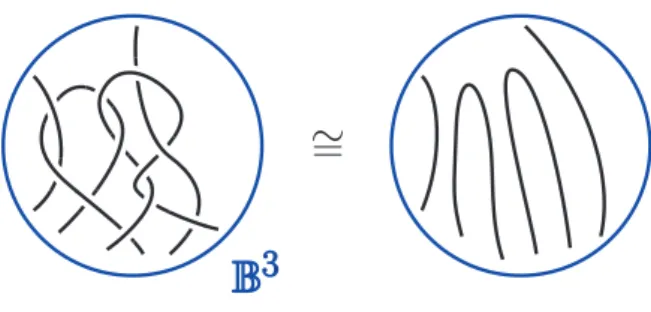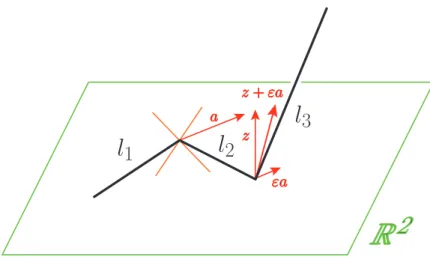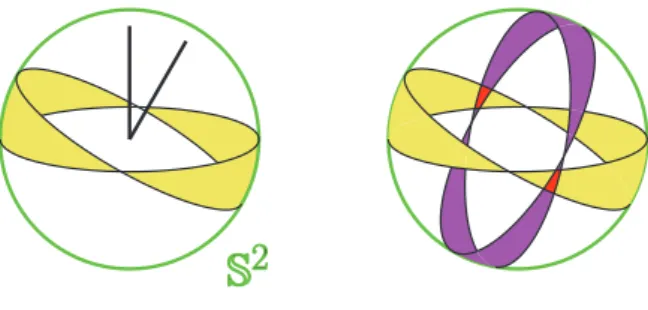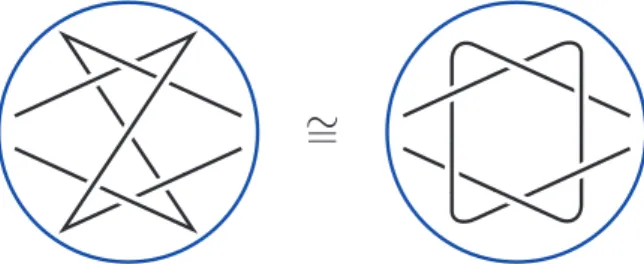Stick number of tangles
谷山 公規 (早稲田大学教育学部)∗1
(Youngsik Huh 氏(Hanyang University)と
Jung Hoon Lee 氏(Chonbuk National University)との共同研究 )
1.
序文この報告は2016年 12月 20日(火)から23 日(金)まで日本大学文理学部 百周年 記念館 国際会議場にて開催された研究集会「結び目の数学 IX 」における表題の講演 内容をまとめたものです。世話人の茂手木公彦先生、市原一裕先生に厚く御礼申し上 げます。
与えられたknot typeを実現するn-gonのnの最小数は何かという問題は素朴な問題 でして、古くは例えば[2]のChapter IのExercise 2. には「4-gonや5-gonは全てtrivial knotであることを示せ。また6-gonや7-gonではどのようなknot typeが作れるか?」
という演習問題が収録されています。論文としてこの問題が考察されたのは[5]が最初 だと思います。これに続く[4]でもJin先生はpolygon indexという用語を使われていま
すが、[1]でstick numberという用語が使われてからこちらの用語のほうがよく使われ
ているようです。今回の共同研究者のYoungsik HuhさんとJung Hoon Leeさんはとも にJin先生のお弟子さんですがstick numberという用語を使われていますので、この 報告の題名もStick number of tanglesとなっています。
knotのstick numberについてはいろいろと研究がなされています。ここではknotの
代わりにtangleについて類似の問題を考えます。tangleについては今までこのような
考察はなされていませんでした。一応まとまった結果が出ましたので以下にご報告致 します。詳細につきましては[3]をご参照頂ければと思います。
B3 を xyz-空間R3 内のunit 3-ballとします。T = t1 ∪ · · · ∪ tn をB3 に properly embeddedされたn mutually disjoint simple arcsとします。このときpair (B3, T)を n-string tangleと呼びます。tangle (B3, T)がtrivialとは、B3にproperly embeddedされ たdiskDでT ⊂Dであるものが存在するときに云います。tangle (B3, T)がstick tangle であるとは、Tが有限個の直線分の和集合であるときに云います。(B3, T)をstick tangle
とし、T =t1∪ · · · ∪tnとします。各tiは有限個の直線分の和集合ですが、その最小数
をaiとします。適当に順番を入れ替えてa1 ≥ a2 ≥ · · · ≥anとしておきます。このと き数列a1, a2,· · · , anを(B3, T)のorderと云うことにしてorder(B3, T) = a1, a2,· · ·, an と記すことにします。さて、a1 ≥ a2 ≥ · · · ≥ an ≥ 1を満たす整数列a1, a2,· · · , anが stick-tangle-order-trivialとは、order(B3, T) = a1, a2,· · · , anである任意のstick tangle (B3, T)がtrivialであることとします。そうでないときにstick-tangle-order-nontrivial と云うことにします。
∗1〒169-8050 東京都新宿区西早稲田1-6-1早稲田大学教育学部数学科 e-mail:taniyama@waseda.jp
定理 1.1 a1, a2,· · · , anをa1 ≥ a2 ≥ · · · ≥ an ≥ 1を満たす整数列とする。このとき a1, a2,· · · , anがstick-tangle-order-nontrivialであるための必要十分条件は次の(1)から (5)までのどれかが成立することである。
(1) a1 ≥5,
(2) a1 = 4, a2 ≥2, (3) a1 =a2 = 3,
(4) a1 = 3, a2 =a3 = 2, (5) a1 =a2 =a3 =a4 = 2.
2.
証明の概略補題 2.1 (B3, T)をtangleとする。T が端点以外にz座標に関するlocal minimumを持 たないならば(B3, T)はtrivialである。
B
3∼ =
図 2.1: A tangle without local minima is trivial.
証明 上図のように上手に変形すれば示せます。
補題 2.2 R3内に3本の直線分l1, l2, l3がありL=l1∪l2∪l3は閉区間と同相であり、L はR3のどの平面にも含まれないとする。このときR3のある方向が存在して、その方 向に関してLは端点以外にlocal maximumもlocal minimumも持たない。
R 2
l 1 l 2
l 3
z a
εa z+εa
図 2.2: L has no local maxima nor minima with respect to (z+εa)-direction.
証明 上図のように上手に方向を選べば示せます。l1∪l2がxy-planeR2にのっている 場合に、R2上のベクトルaをl1∪l2が端点以外にlocal maximumもminimumも持たな い方向として選び、z-axis のベクトルzと十分小さいεに関してベクトル(z+εa)を方 向として選べばよいことが分かります。
注 2.3 この補題2.2は素朴ですがknotのstick numberの研究に関して効果的です。例 えば5-gonはtrivial knotであることは、この補題からある方向に関してcritical points が高々3個、critical pointsは偶数個ですから2個、よって1-bridge knotであることか ら示せます。同様の議論で(p, p+ 1)-torus knotのbridge indexがpであることと、この 補題からそのstick numberは2p+ 2以上であることが分かり、一方で2p+ 2本のstick で実現出来るのでstick numberは2p+ 2であると決定されます。
またこの補題と同じ仮定の下で、ある方向が存在して、その方向に関してLは端点 以外にlocal maximumとlocal minimumをともに持つことが示せます。このことは空
間曲線のtotal curvatureの研究に関して基本的な事実となっています。文献としては
[6]だけ挙げておきます。
定理の証明 最初に必要条件であることを示します。それには次の数列は全てstick- tangle-order-trivialであることを示せば十分です。
(a) 4,1,1,· · · ,1 (b) 3,2,1,1,· · · ,1
(c) 2,2,2,1,1,· · · ,1
実際に定理の(1)から(5)までのどれも満たさない数列は上記の(a),(b),(c)のどれかの 部分列になります。(a)と(b)については補題2.2より端点以外にはあったとしてもlocal maximumかlocal minimumがどちらか1つだけの方向があるので補題2.1よりtrivial と分かります。(c)についてですが、2,2,2のうちの2つの2,2について、図2.3のよう
S
2図 2.3: The common red direction has no critical points.
に、どちらも端点以外にcritical pointを持たない方向が選べます。よってcritical point は高々1つだけとなり補題2.1よりtrivialとなります。
次に十分条件であることを示します。それには定理の(1)から(5)までのそれぞれを orderとするnontrivial tangleが存在することを示せば十分です。(1)は図2.4のtangle がその例になります。
B
3図 2.4: A nontrivial tangle with 5 sticks.
(2)は図2.5のtangleがその例になります。
∼ =
図 2.5: A nontrivial tangle with 4 + 2 sticks.
(3)は図2.6のtangleがその例になります。
(4)は図2.7のtangleがその例になります。
(5)は図2.8のtangleがその例になります。各成分は緑の正4面体の各面を含む平面
上にのっています。
∼ =
図 2.6: A nontrivial tangle with 3 + 3 sticks.
図 2.7: A nontrivial tangle with 3 + 2 + 2 sticks.
図 2.8: A nontrivial tangle with 2 + 2 + 2 + 2 sticks.
参考文献
[1] C. Adams, B. Brennan, D. Greilsheimer, and A. Woo, Stick numbers and composition of knots and links, J. Knot Theory Ramifications,6 (1997), 149-161.
[2] R. Crowell and R. Fox, Introduction to knot theory, Reprint of the 1963 original. Graduate Texts in Mathematics, No. 57. Springer-Verlag, New York-Heidelberg, 1977. x+182 pp.
[3] Y. Huh, J. H. Lee and K. Taniyama, Stick number of tangles, preprint (2016).
[4] G. T. Jin, Polygon indices and superbridge indices of torus knots and links, J. Knot Theory Ramifications,6 (1997), 281-289.
[5] G. T. Jin and H. S. Kim, Polygonal knots, J. Korean Math. Soc.30(1993), 371-383.
[6] J. Milnor, On the total curvature of knots, Ann. Math.,52 (1950), 248-257.



